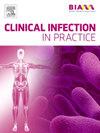Evaluating factors influencing mortality, neurological morbidity and length of stay in adults admitted with community-onset brain abscess in a UK tertiary referral centre
Q3 Medicine
引用次数: 0
Abstract
Background
Despite advances in diagnostics and therapeutics, morbidity and mortality associated with brain abscess remains high. Until recently no evidence-based guidelines existed, resulting in heterogeneous practice. In this study we explore the impact of host, pathogen and therapy-related factors on clinical outcomes.
Methods
We retrospectively reviewed adult patients with community-onset brain abscess from October 2016 to April 2020 using hospital databases. Clinical, radiological, biochemical, microbiological, and surgical data was collected. Primary outcome was the 6 month modified Rankin Scale (mRS), secondary outcomes included length of hospital stay (LOS), neurological sequelae, and 1-year mortality. Multivariate logistic regression was used to analyse factors influencing recovery and neurological sequelae; and multivariate Cox regression for LOS.
Results
Sixty adults with brain abscess (median age 57 years; 63 % male) were identified. Forty-eight patients (80 %) had a solitary abscess, most commonly in the frontal lobe. A causative organism was identified in 49 of 54 cases (91 %) where samples were collected, with Streptococcus milleri group the most common organism. Median duration of intravenous and oral therapy was 21 and 28 days respectively. Forty-three patients had an mRS of ≤ 2 (slight disability or better) at 6 months, with CRP > 6 mg/l on admission associated with poor outcome (mRS > 2) (p = 0.036). Eight patients (13 %) died within one year. Age > 60 years (p = 0.001), CRP > 6 mg/l (p = 0.048) and prolonged intravenous therapy (>6 weeks) (p = 0.001) were all associated with extended LOS. Seizures on admission (p = 0.017) or presence of risk factors (p = 0.032) were associated with neurological sequelae at 6 months.
Conclusions
This study reveals that a complex interaction of factors related to host, pathogen and therapy impacts clinical outcome in patients with brain abscess. While mortality and LOS are well described in previous literature, analysis of the mRS here adds to our understanding of morbidity following a diagnosis of brain abscess.
评估英国一家三级转诊中心收治的社区发病脑脓肿成人的死亡率、神经系统发病率和住院时间的影响因素
背景尽管诊断和治疗技术不断进步,但与脑脓肿相关的发病率和死亡率仍然很高。直到最近,还没有基于证据的指南,导致了不同的实践。在本研究中,我们探讨了宿主、病原体和治疗相关因素对临床结果的影响。方法 我们利用医院数据库回顾性地分析了 2016 年 10 月至 2020 年 4 月间社区发病的脑脓肿成年患者。收集了临床、放射学、生化、微生物学和手术数据。主要结果是6个月的改良Rankin量表(mRS),次要结果包括住院时间(LOS)、神经系统后遗症和1年死亡率。多变量逻辑回归用于分析影响康复和神经系统后遗症的因素;多变量考克斯回归用于分析住院时间。48名患者(80%)为单发脓肿,最常见于额叶。在采集样本的 54 个病例中,49 个病例(91%)确定了致病菌,其中最常见的致病菌是毫雷链球菌。静脉注射和口服治疗的中位持续时间分别为 21 天和 28 天。43名患者在6个月后的mRS≤2(轻微残疾或更好),入院时CRP大于等于6毫克/升与不良预后(mRS大于等于2)有关(p = 0.036)。八名患者(13%)在一年内死亡。年龄(60 岁)(p = 0.001)、CRP(6 毫克/升)(p = 0.048)和长时间静脉注射治疗(6 周)(p = 0.001)都与延长生命周期有关。入院时癫痫发作(p = 0.017)或存在危险因素(p = 0.032)与 6 个月时的神经系统后遗症有关。虽然死亡率和住院时间在以往的文献中有详细描述,但此处对 mRS 的分析增加了我们对脑脓肿诊断后发病率的了解。
本文章由计算机程序翻译,如有差异,请以英文原文为准。
求助全文
约1分钟内获得全文
求助全文
来源期刊

Clinical Infection in Practice
Medicine-Infectious Diseases
CiteScore
2.10
自引率
0.00%
发文量
95
审稿时长
82 days
 求助内容:
求助内容: 应助结果提醒方式:
应助结果提醒方式:


